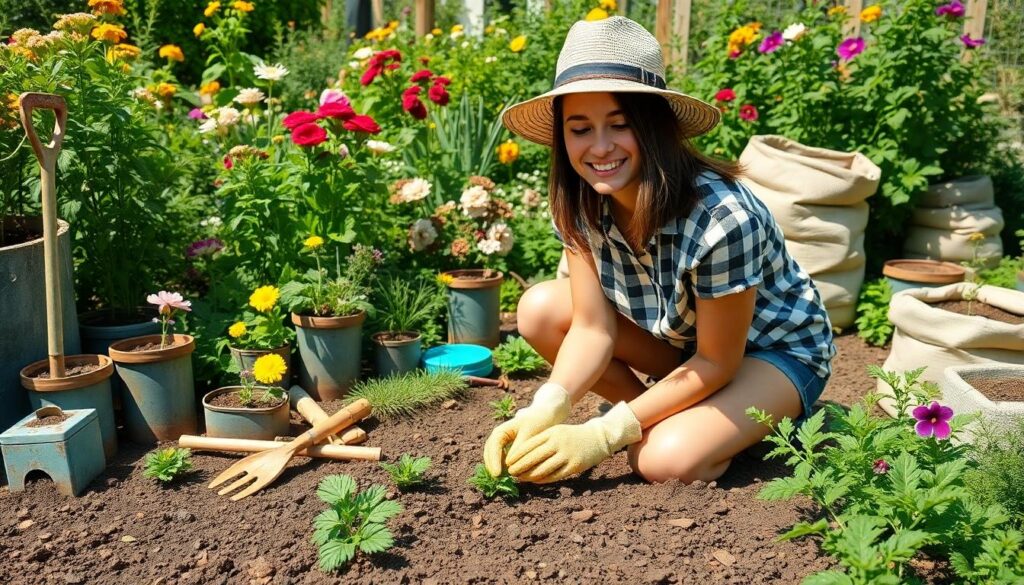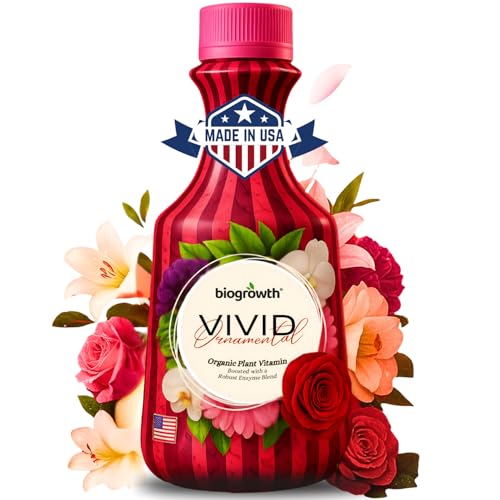Are you ready to transform your garden into a lush paradise without very costly or becoming a horticultural expert? We’ve compiled the ultimate list of genius garden hacks that professional gardeners swear by but rarely share with the public.
Whether you’re battling persistent weeds, struggling with poor soil quality, or simply looking to maximize your garden’s potential, these expert shortcuts will revolutionize your gardening experience. From using everyday household items in surprising ways to employing time-saving techniques that deliver professional results, we’ll show you how to work smarter, not harder in your garden this season.
10 Time-Saving Garden Hacks Expert Gardeners Swear By
- Use coffee grounds as fertilizer for acid-loving plants like azaleas, rhododendrons, and blueberries. Simply sprinkle used coffee grounds around the base of these plants to provide nitrogen and improve soil structure. Your morning coffee ritual can become part of your garden routine without any extra cost or effort.
- Create newspaper weed barriers when planting new garden beds. Lay several layers of newspaper down, wet them thoroughly, and cover with mulch before planting. This sustainable approach prevents weeds for months while gradually decomposing to enrich your soil naturally.
- Repurpose plastic milk jugs as watering cans by poking small holes in the cap and filling with water. These makeshift watering devices deliver gentle irrigation to seedlings and delicate plants without causing soil erosion or damaging tender stems.
- Start seeds in eggshells to get a jump on the growing season. Fill half eggshells with potting soil, plant your seeds, and place in egg cartons near a sunny window. When ready to transplant, crush the shell slightly and plant directly in the ground for an added calcium boost.
- Use vinegar as a natural weed killer by spraying undiluted white vinegar directly on unwanted plants on a sunny day. The acetic acid draws moisture from weeds, causing them to die within 24 hours without introducing chemicals to your garden network.
- Create self-watering planters using plastic bottles. Cut bottles in half, invert the top portion into the bottom, and fill the top with soil while keeping water in the base. The soil will draw up moisture as needed, reducing watering frequency by 50%.
- Apply cinnamon to seedlings to prevent damping off disease that commonly kills young plants. Sprinkle a light dusting on the soil surface around newly emerged seedlings to create a natural fungicide barrier that protects vulnerable stems.
- Collect rainwater in barrels positioned under downspouts to capture free irrigation water. Installing a simple rain barrel system can save up to 1,300 gallons of water during peak growing seasons while providing chemical-free water for sensitive plants.
- Plant perennials in fall instead of spring to establish stronger root systems before summer heat arrives. Fall planting allows roots to develop while plants remain dormant aboveground, resulting in 30% more growth during the following season with less watering required.
- Employ companion planting strategies by placing compatible plants together. Growing basil near tomatoes improves flavor and repels pests, while planting marigolds throughout vegetable gardens reduces nematode populations by 90% without chemical interventions.
Transform Your Garden With Newspaper and Cardboard Mulch Techniques
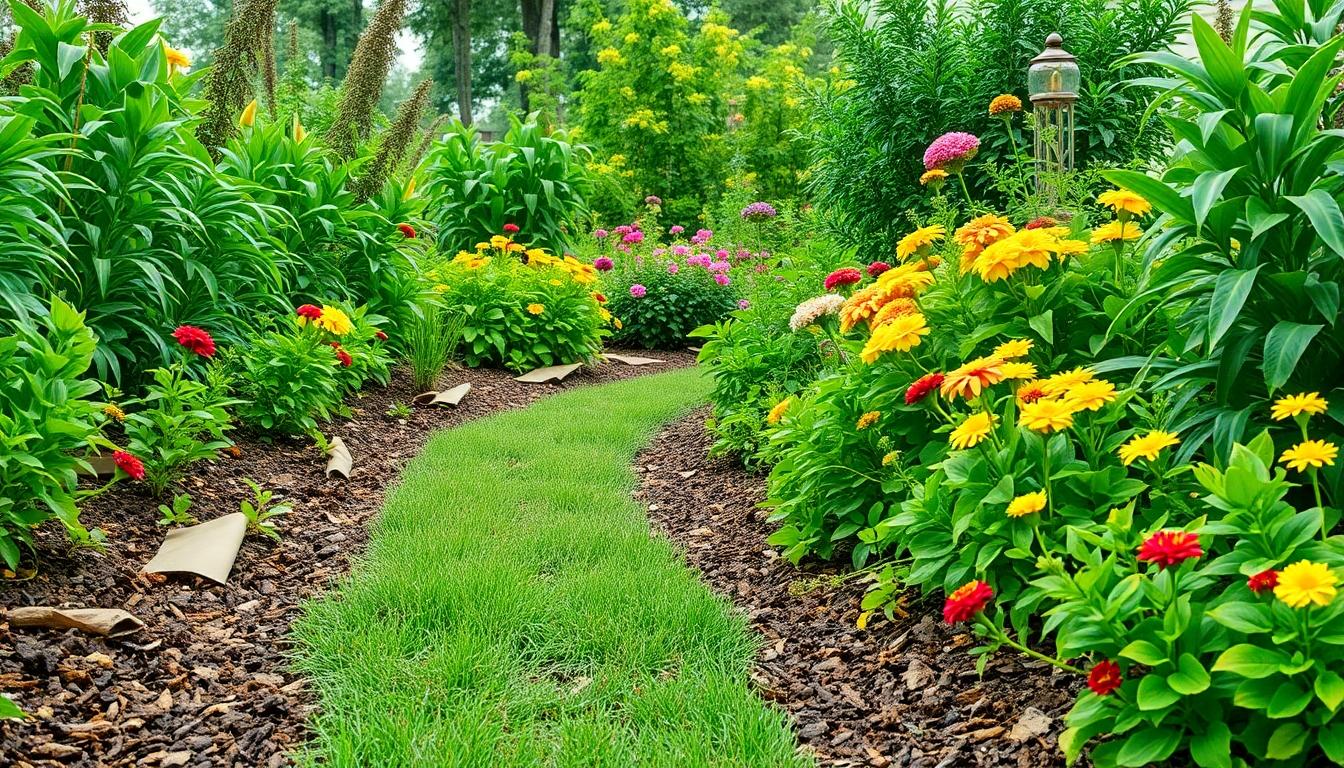
Sheet mulching with newspaper and cardboard offers an eco-friendly, cost-effective solution for garden maintenance. These everyday materials can be repurposed to create weed barriers that eventually break down into nutrient-rich compost for your soil.
How To Layer Newspaper to Block Weeds
Newspaper layering is an incredibly effective technique for preventing persistent weeds from taking over your garden beds. First, clear the intended area of any debris and existing weeds to create a clean surface. Next, place multiple sheets of newspaper (typically 2-4 layers thick) directly on the soil or grass, making sure to overlap the edges by several inches to prevent gaps where weeds might emerge. Thoroughly wet the newspaper to keep it in place and accelerate decomposition. Finally, cover the newspaper layer with 2-3 inches of organic mulch such as wood chips, straw, or compost to hold everything down and create an attractive finish. This natural barrier blocks sunlight from reaching weed seeds while allowing water and nutrients to penetrate to your plants’ roots, significantly reducing maintenance time throughout the growing season.
Creating Pathways With Cardboard Barriers
Garden pathways often become weed magnets, but cardboard offers a simple solution to this common problem. Start by collecting large pieces of cardboard or flattened cardboard boxes, removing any tape or staples that might contain non-biodegradable materials. Lay these pieces along your desired pathway, overlapping edges by at least 6 inches to ensure complete coverage. For curved paths, smaller pieces work better to follow the contours naturally. Water the cardboard thoroughly to prevent it from blowing away and to jumpstart decomposition. Top the cardboard with a generous 3-4 inch layer of mulch, gravel, or wood chips depending on your aesthetic preference. This method not only suppresses weeds effectively but also creates clearly defined walking areas that protect your garden beds from foot traffic compaction. The cardboard eventually breaks down, adding organic matter to the soil beneath while the top layer maintains a neat, professional appearance.
Maximize Growth With DIY Organic Fertilizer Solutions
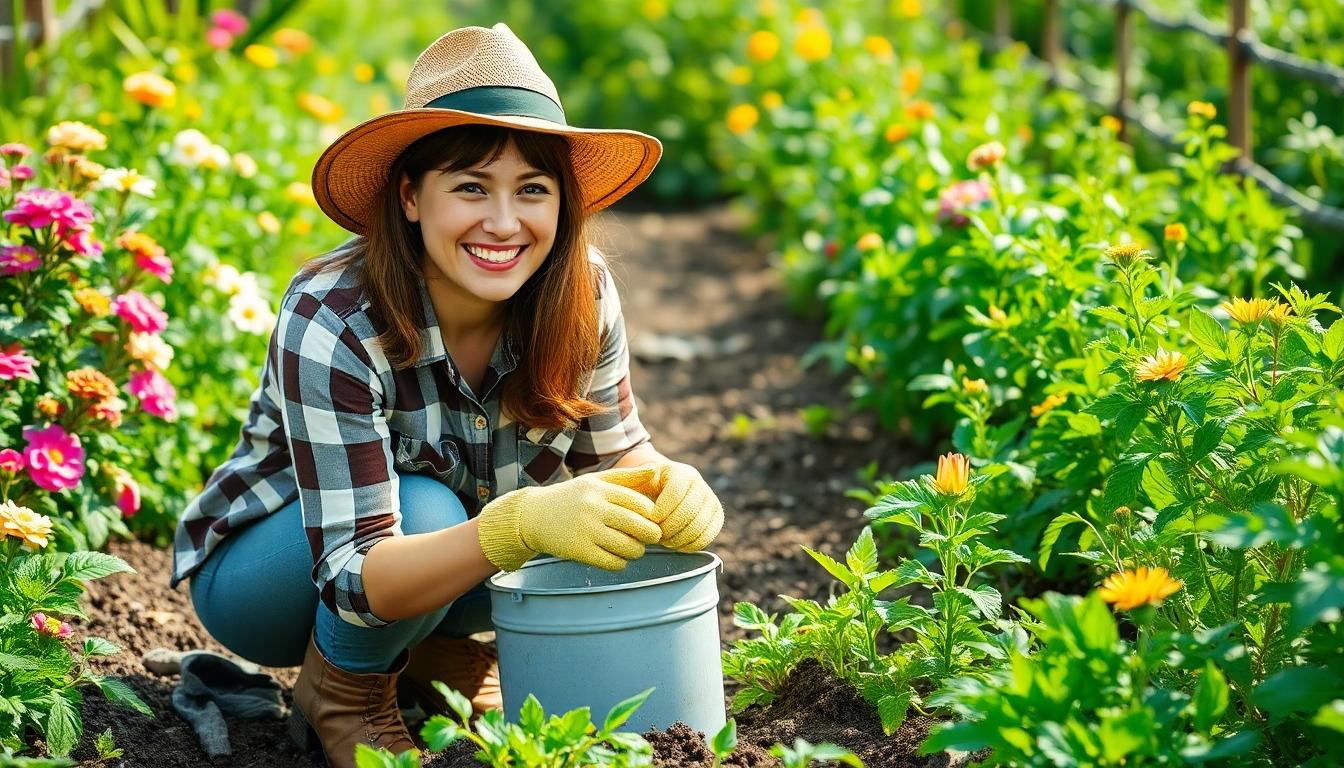
Looking to supercharge your garden naturally without expensive commercial products? DIY organic fertilizers offer a cost-effective way to nourish your plants while reducing waste.
Egg Shells and Coffee Grounds: Transform your breakfast remains into garden gold! Crushed eggshells work wonders for deterring pests like slugs and snails while simultaneously improving soil structure. Coffee grounds enrich your garden soil with nitrogen, which is essential for lush foliage and strong plant growth.
Epsom Salt: This common household item delivers a powerful punch of magnesium and sulfur to your garden beds. Plants use these minerals for critical growth functions, resulting in greener leaves and more abundant blooms.
Flour as a Weed Barrier: Sprinkle a thin layer of flour over soil areas where you want to prevent weeds. This simple kitchen staple creates a natural barrier that inhibits weed seed germination without harmful chemicals.
Kitchen Scraps That Supercharge Your Soil
Composting: Don’t toss those vegetable peels and fruit scraps! Uncooked plant-based kitchen waste can be recycled into nutrient-rich compost that feeds your soil naturally. Collecting items like apple cores, banana peels, and vegetable trimmings creates a continuous supply of organic matter for your garden.
Weed and Trimming Compost: Those pesky weeds you pull from garden paths can actually benefit your garden once they break down. Collect weeds (before they go to seed) and plant trimmings in a separate pile, allowing them to decompose into valuable organic material that improves soil structure and fertility.
Brewing Compost Tea for Plant Nutrition
Compost Tea: This liquid fertilizer powerhouse is created by steeping finished compost in water, producing a solution rich in beneficial microbes. Regular applications of compost tea enhance soil health while providing plants with readily available nutrients for optimal growth.
Supporting Beneficial Microbes: Healthy soil depends on thriving microbial communities that break down organic matter and make nutrients available to plants. Compost tea introduces these helpful organisms directly to your soil network, fostering a naturally balanced environment where plants flourish without synthetic inputs.
Repurpose Household Items for Smart Garden Solutions
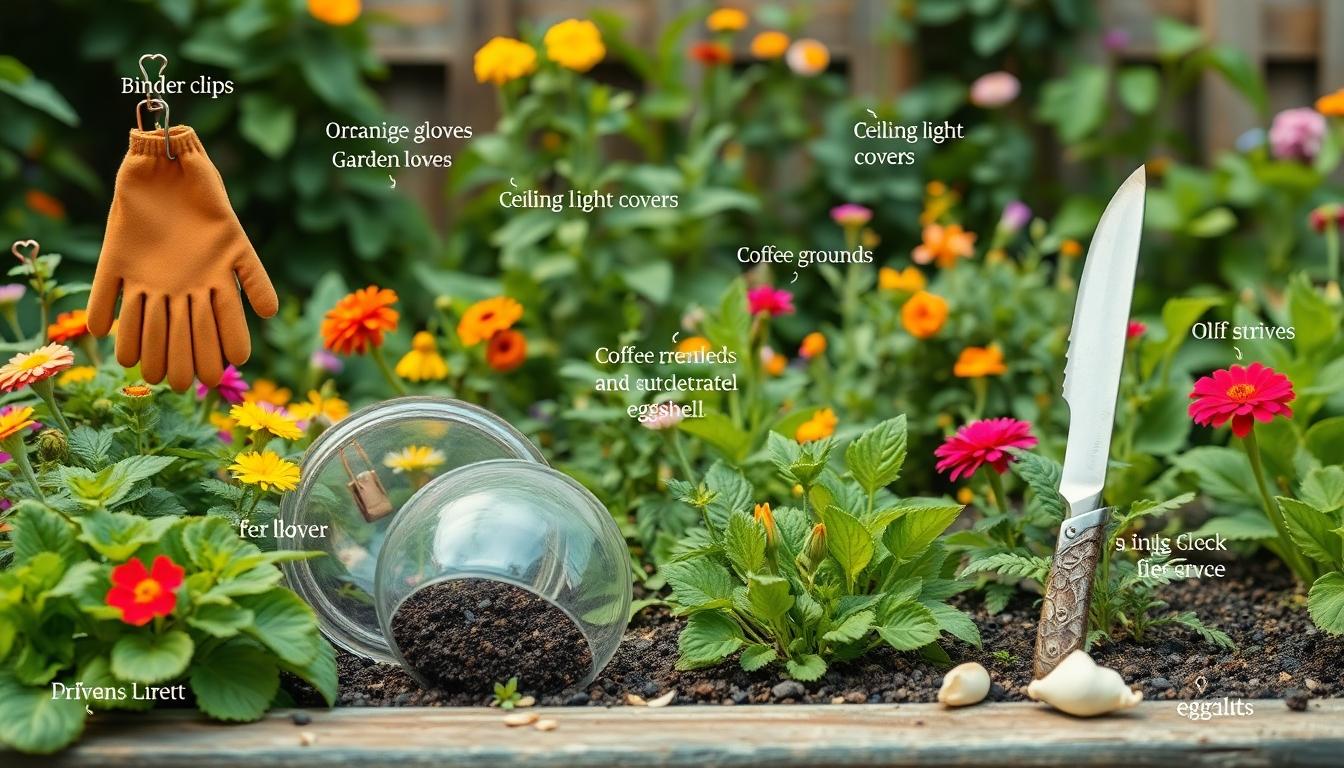
Turn your ordinary household items into extraordinary garden tools with these expert-approved hacks. These creative repurposing ideas will save you money while solving common gardening challenges.
Binder Clips for Garden Organization
Binder clips serve as perfect glove hangers when attached to shelves or walls in your garden shed. They provide an efficient way to dry and store gloves, keeping them organized and ready for use. You’ll find this simple solution eliminates the frustration of misplaced or damp garden gloves.
Kitchen Knife Transformations
Old serrated kitchen knives make excellent weeding and edging tools for precise garden maintenance. Thrift shops offer these tools at bargain prices, allowing you to build a collection of specialized garden implements without very costly. We recommend choosing knives with comfortable handles for extended garden sessions.
Unexpected Plant Protectors
Ceiling light covers can be repurposed as clever squirrel deterrents for bird feeders or rain shields for delicate plants. These dome-shaped protectors create a barrier that keeps unwanted visitors away while still allowing access to feed or sunlight.
Polyester quilt batting works wonders for cleaning pond sludge naturally. Simply float the batting on water surfaces to absorb organic matter without introducing harmful chemicals to your garden network.
Support heavy fruits like melons or squash using old pantyhose or bras attached to trellises. This prevents vine breakage and keeps developing produce off the ground, reducing rot and pest damage.
Household Cleaners for Garden Tools
Fizzy drinks contain acids that effectively break down rust on garden tools. Soak rusty implements overnight in soda or apply with cloths to restore their functionality. White vinegar mixed with water in equal parts creates a powerful solution for cleaning patios and removing stubborn stains from garden surfaces.
Creative Container Answers
Transform cake tins into charming garden stepping stones by filling them with cement. This DIY project adds personality to your garden pathways while repurposing items that might otherwise be discarded. You can personalize these stones with decorative elements pressed into the wet cement.
Coffee Grounds: The Secret Weapon for Acid-Loving Plants
Coffee grounds work as an excellent soil acidifier for plants that thrive in lower pH environments. Sprinkle used grounds around blueberries, azaleas, or rhododendrons to naturally adjust soil acidity to their preferred levels.
Adding coffee grounds to compost bins significantly boosts nitrogen content while improving the overall texture of your finished compost. The grounds help create a rich, diverse environment for decomposing organisms.
Dried coffee grounds can also function as an effective pest deterrent when scattered around vulnerable plants. Create protective barriers to repel slugs and snails, but always ensure the grounds are completely dry to prevent mold growth.
Eggshells for Calcium-Rich Soil and Pest Control
Crushed eggshells serve as a powerful soil amendment that prevents common garden problems. Pulverize shells into powder or small pieces and mix them into soil to prevent blossom-end rot in tomatoes and peppers by providing essential calcium.
Coarse eggshell fragments scattered around plants create an uncomfortable barrier for soft-bodied pests. Slugs and snails avoid crossing these sharp edges, providing natural protection without chemicals.
Half eggshells make perfect biodegradable seed-starting pots that can be planted directly into the garden. This method eliminates transplant shock while adding nutrients to the soil as the shells decompose around developing root systems.
Master Water Conservation With Drip Irrigation Tricks
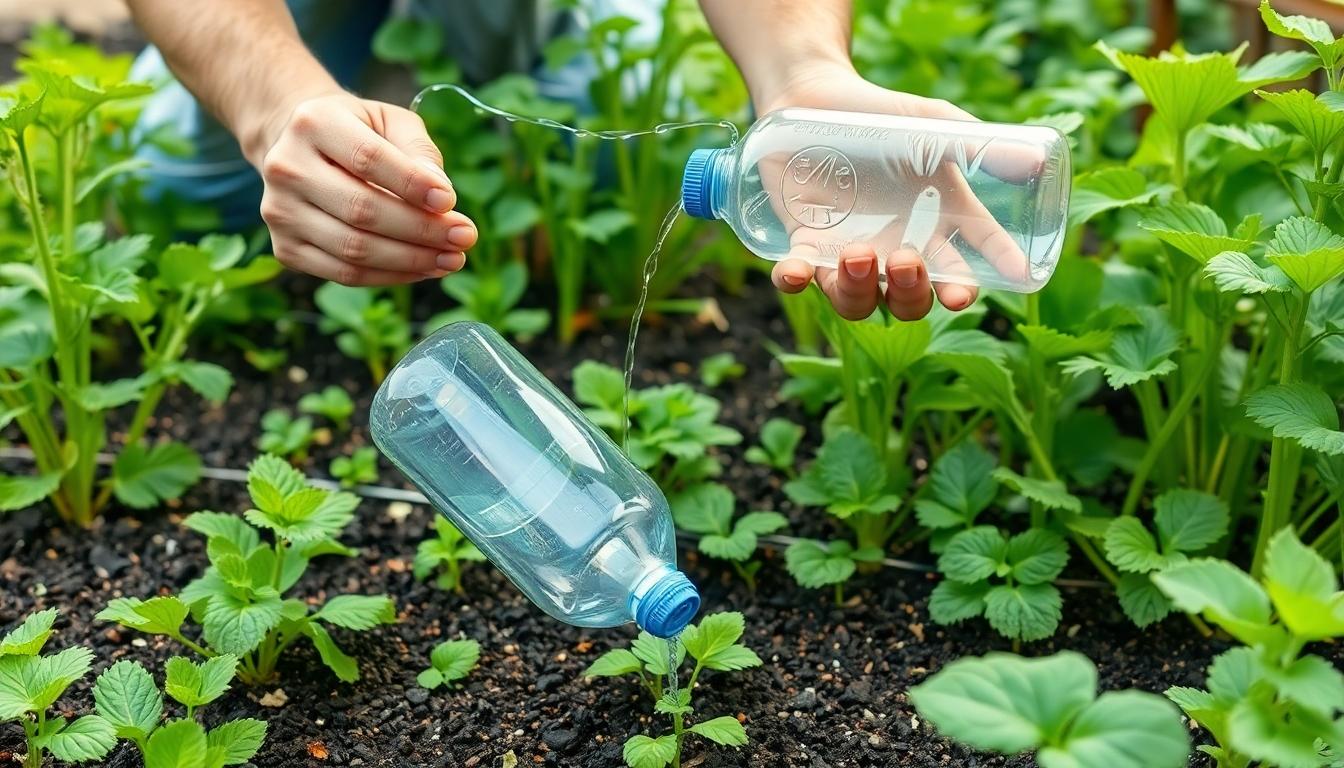
Drip irrigation delivers water directly to plant roots, significantly reducing waste through evaporation and runoff. To achieve optimal results, place drippers near the base of plants where they’ll provide maximum absorption with minimal water usage.
Building a Self-Watering System From Recycled Bottles
Transform ordinary plastic bottles into efficient water reservoirs for your garden beds. Start by cutting the bottom off a clean plastic bottle and burying it near your plants’ root systems. Fill the bottle with water and watch as it slowly seeps into the surrounding soil, providing a steady supply of moisture exactly where plants need it most. This clever recycling solution maintains consistent soil moisture levels while dramatically reducing your watering frequency. The bottle’s narrow opening also minimizes evaporation, making this an excellent water conservation technique during hot summer months.
Strategic Deep Watering Techniques
Focus on watering deeply but infrequently to encourage plants to develop robust, drought-resistant root systems. Deep watering penetrates well below the surface, enticing roots to grow downward in search of moisture instead of staying near the top where they’re vulnerable to heat and dryness. Timing matters tremendously when it comes to efficient watering – early mornings or evenings provide the ideal window when evaporation rates are lowest. Consider implementing olla irrigation, an ancient method using unglazed clay pots buried in garden beds that slowly release moisture as the surrounding soil dries out. Collecting rainwater in barrels creates an eco-friendly water source for your garden that reduces dependence on municipal supplies. Adding several inches of organic mulch around plants serves the dual purpose of retaining soil moisture and suppressing water-hungry weeds, further improving your garden’s water efficiency.
Outsmart Garden Pests With Natural Remedies
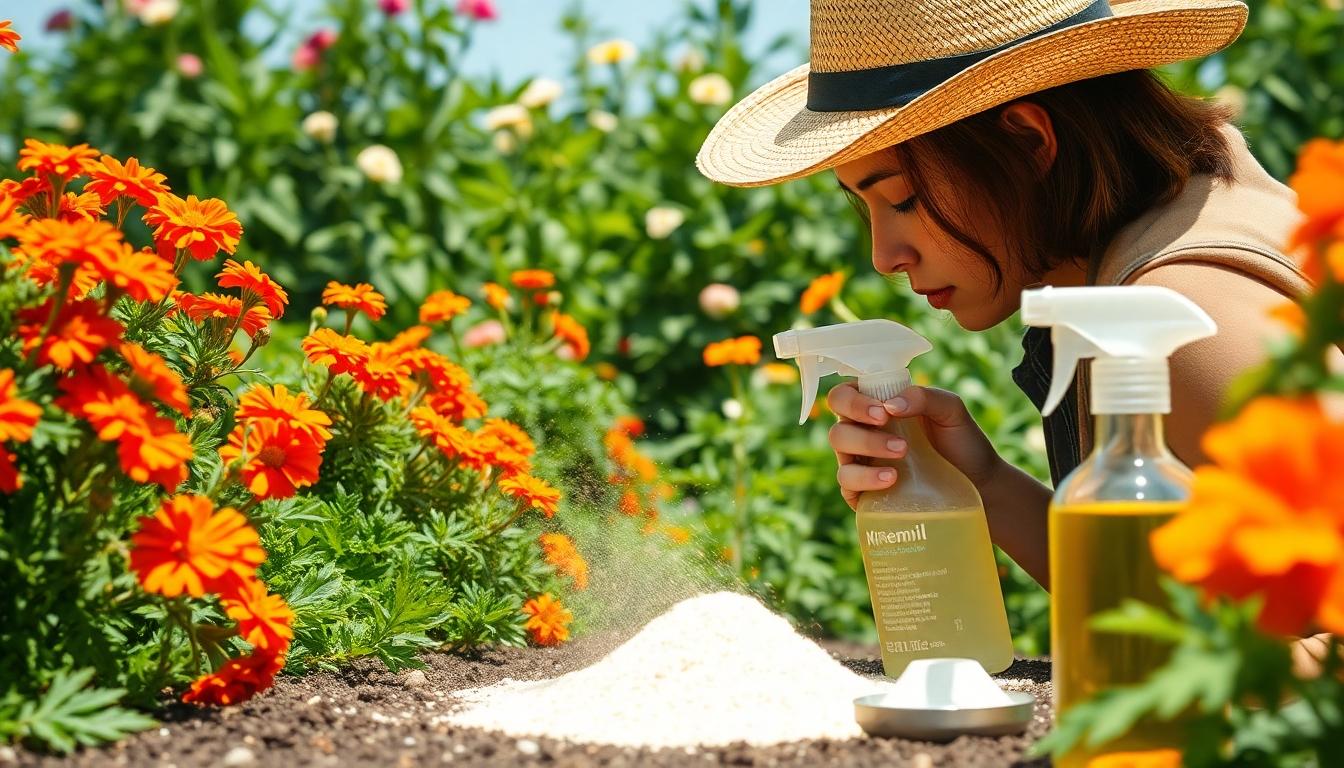
Nature provides some of the most effective answers for keeping garden pests at bay. These expert-approved remedies offer powerful protection without introducing harmful chemicals to your garden network.
Powerful Natural Pest Controls
Neem oil stands out as a remarkable natural pesticide derived from the neem tree. Mix two tablespoons of neem oil with one tablespoon of dish soap in a gallon of water to create an effective bug spray that disrupts pest life cycles while sparing beneficial insects.
Diatomaceous earth provides excellent protection against many crawling pests. This fine powder works by dehydrating insects on contact, making it particularly effective against slugs, snails, and beetles when sprinkled around the base of plants.
Eggshells serve a dual purpose in garden pest management. Crushed shells create a jagged barrier that deters soft-bodied pests like slugs and snails while gradually releasing calcium into your soil as they decompose.
DIY Companion Planting Strategies
Strategic plant pairings can naturally enhance your garden’s resistance to pests while improving overall growth. Companion planting leverages the natural properties of certain plants to protect their neighbors.
Marigolds effectively repel nematodes when planted throughout vegetable gardens. Their bright blooms not only add visual appeal but also serve as a natural pest deterrent.
Basil provides excellent protection for tomato plants. Growing these herbs nearby helps repel mosquitoes and other common garden pests while improving the flavor of your tomatoes.
Lavender works wonderfully to keep moths and various insects away from vulnerable plants. Its strong scent acts as a natural repellent while attracting beneficial pollinators to your garden.
Essential Oil Sprays That Repel Common Pests
Essential oils contain powerful compounds that many garden pests find intolerable. Creating your own repellent sprays with these oils offers targeted protection for your precious plants.
Peppermint oil delivers impressive results against aphids, ants, and beetles. Combine 10-15 drops with water in a spray bottle to create an effective deterrent that smells pleasant to humans but repels many common garden pests.
Lemongrass oil effectively keeps mosquitoes and other flying insects away from garden areas. This citrusy oil can be diluted with water and sprayed on plants to create a protective barrier.
Eucalyptus oil works well against many crawling insects that might damage your plants. Always test these essential oil sprays on a small area first to ensure they won’t damage sensitive plant tissues.
Extend Your Growing Season With Simple Structures
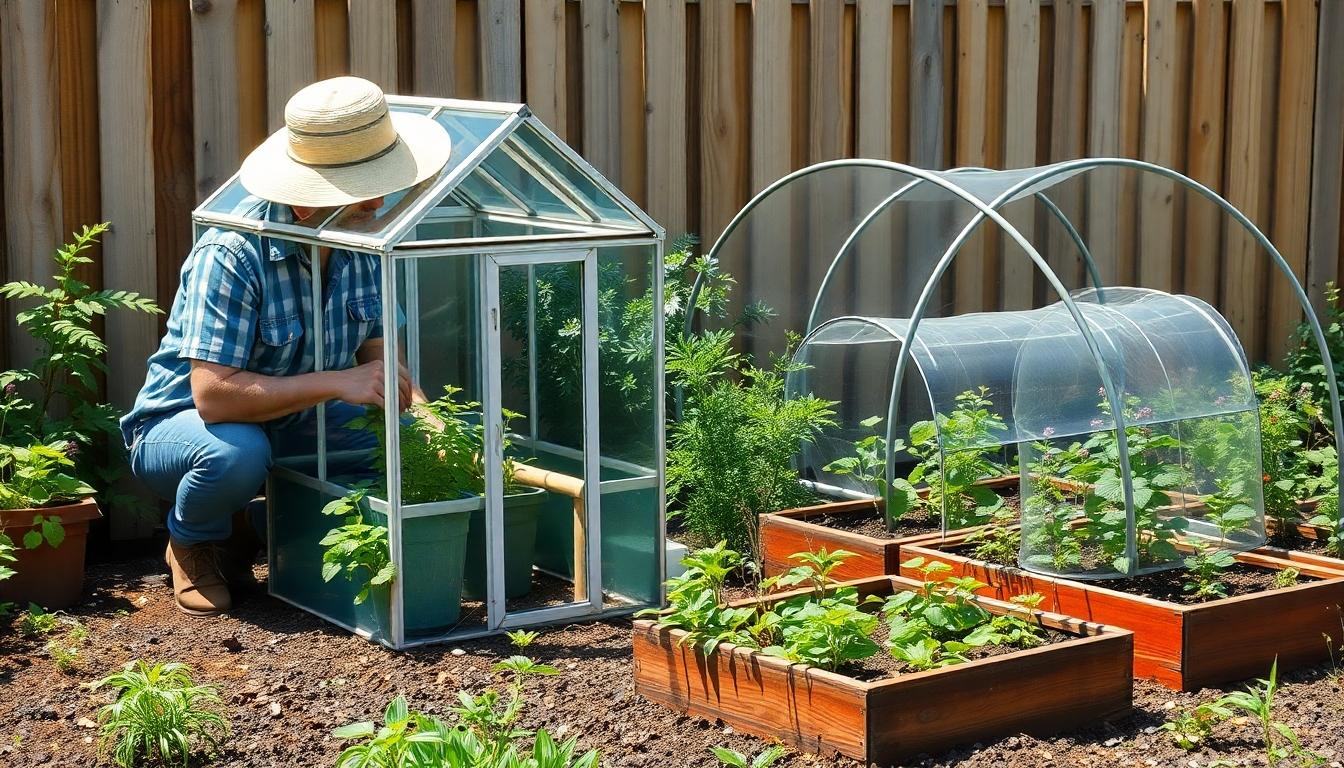
Want to garden longer throughout the year? These DIY structures allow you to start earlier in spring and continue harvesting well into fall without very costly.
Creating Mini Greenhouses From Plastic Containers
Transform everyday household items into protective mini greenhouses for your seedlings and young plants. Large plastic bottles like soda or Gatorade containers make perfect individual plant covers—simply cut off the bottom and place them over small plants, using the cap as a ventilation control point. These makeshift cloches trap heat while protecting delicate seedlings from frost damage, creating a microclimate that encourages growth. For larger plants, we recommend using inverted glass punch bowls or plastic storage containers that serve the same purpose. These mini greenhouses are particularly effective for protecting cold-sensitive plants during unexpected temperature drops and extending your growing season by several weeks on either end of the traditional gardening calendar.
Cold Frame Construction Using Salvaged Windows
Build your own cold frames to create protected growing spaces using materials you might already have on hand. Old windows serve as ideal transparent tops for cold frames, allowing sunlight to penetrate while trapping heat inside the wooden box structure. When constructing your cold frame, position the back edge higher than the front to maximize sun exposure and help rainwater runoff. Installing a thermometer inside helps monitor conditions, as proper ventilation becomes crucial on sunny days to prevent overheating. Cold frames work perfectly for hardening off seedlings, growing cool-weather crops like lettuce and spinach during winter months, and extending your harvest season significantly. The beauty of these structures lies in their simplicity—they require no electricity yet provide effective season extension through passive solar heating.
Building Simple Hoop Houses
PVC pipes offer an affordable way to create protective tunnels over your garden beds. Bend these flexible pipes into arches and secure them over your growing area to form the skeleton of your hoop house. Row covers or thick greenhouse plastic draped over this framework creates an instantly warmer environment for your plants. For raised beds, you’ll find it easiest to attach the PVC directly to the sides of the bed, connecting the arches with a central spine pipe for additional stability. Hoop houses prove especially effective for warming soil in early spring and protecting fall crops from early frosts, potentially adding months to your growing season. These structures work with nearly any garden bed configuration and can be easily removed and stored when not needed.
Hybrid Growing Structures
Combine different season-extension techniques to maximize effectiveness for your exact garden needs. Attaching greenhouse plastic to existing trellises creates instant polytunnels that serve dual purposes of plant support and weather protection. Remember that smaller structures generally retain heat more effectively than larger ones, making them more efficient for season extension. We recommend designing portable options using lightweight materials that allow for seasonal adjustments as temperatures change throughout the year. The versatility of hybrid structures makes them perfect for gardeners with limited space who need multi-functional growing answers that can adapt to changing weather conditions and seasonal requirements.
Propagate Plants for Free Using Expert Cutting Methods
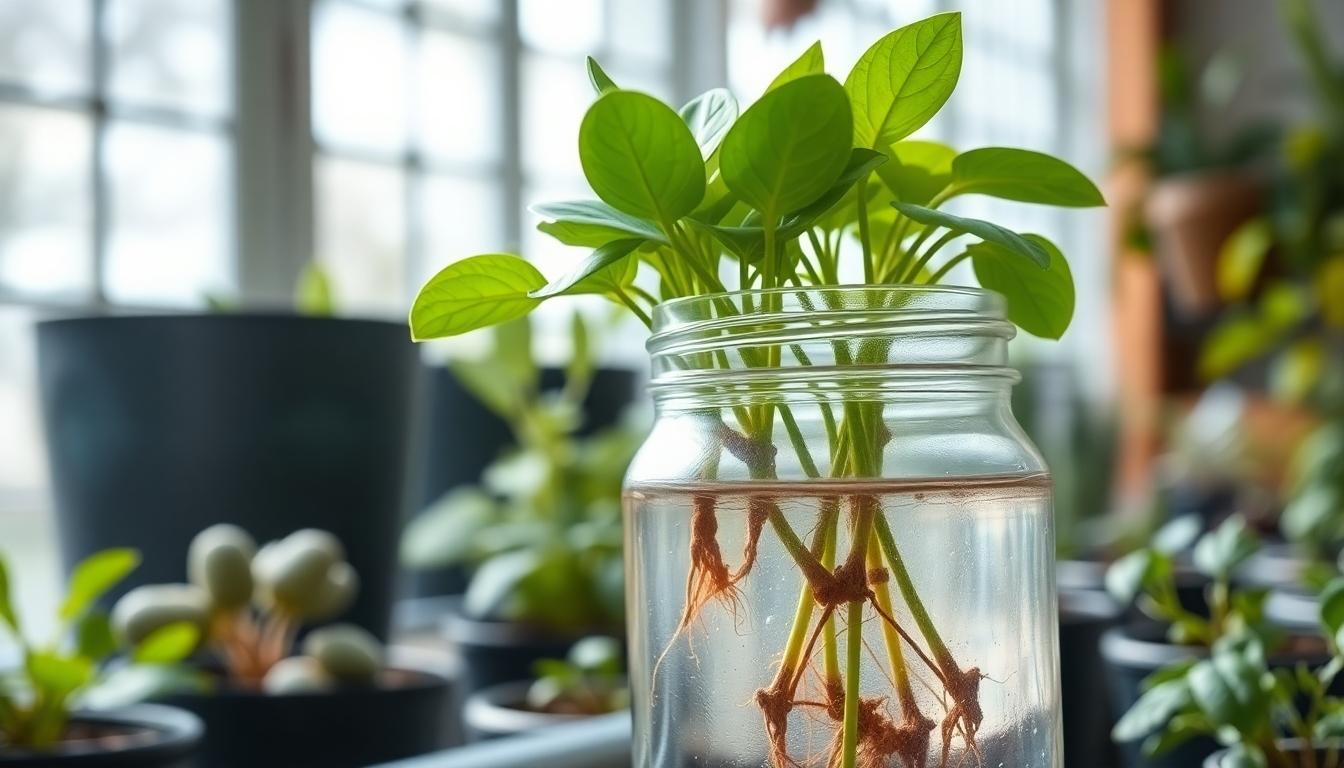
Want to expand your plant collection without spending money? Propagation through cuttings is a simple yet effective method that every gardener should master. We’ve gathered the most reliable techniques to help you multiply your favorite plants with minimal effort.
Water Propagation Techniques for Houseplants
Water propagation offers a straightforward way to grow new plants from cuttings. To start, select healthy stems from pest-free plants with at least four leaves intact. Look for nodes (the points where leaves or branches emerge) and cut just below them for better rooting success. Timing matters significantly – taking cuttings during the active growing season dramatically increases your success rate.
For optimal results, place your water containers in bright, indirect light while maintaining room temperature. Remember to change the water every few days to prevent bacterial growth and root rot. Monitor root development closely – once roots reach about 1-2 inches, they’re typically ready for soil transplanting. Allowing roots to grow too long in water can sometimes make the transition to soil more difficult.
Rooting Hormone Alternatives From Your Kitchen
Don’t have commercial rooting hormone? Your kitchen likely contains effective natural alternatives. Cinnamon serves as an excellent natural fungicide that can enhance root formation – simply sprinkle a small amount on the cut end before placing it in water or soil. Aloe vera gel contains compounds that actively promote root growth; apply a thin layer to the cut end before propagation.
For an extra nutrient boost, consider using banana water. This potassium-rich solution stimulates plant growth effectively. Create it by soaking banana peels in water, then place your cuttings in this nutrient bath for a few hours before transferring them to regular water. These kitchen-sourced alternatives provide an eco-friendly way to improve propagation success without purchasing specialized products.
Space-Saving Vertical Garden Solutions for Any Yard
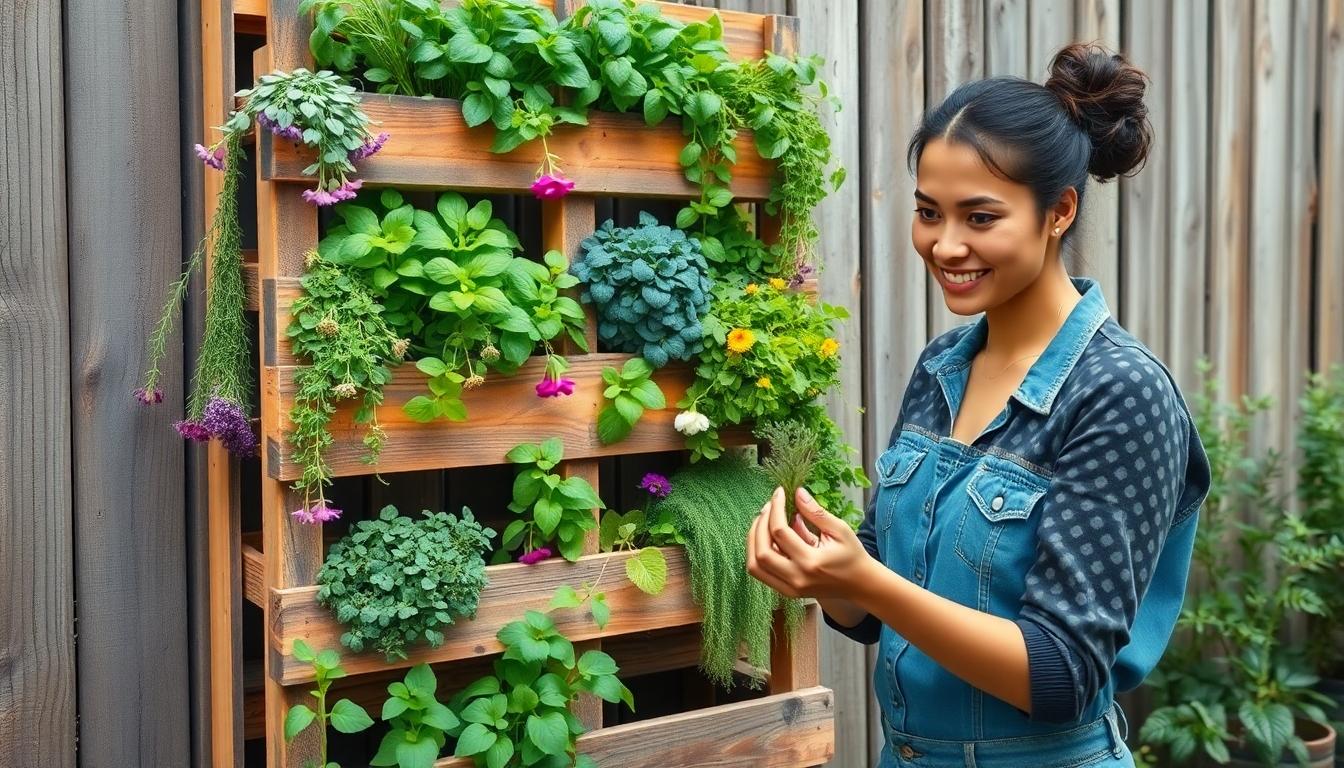
Vertical gardens offer an ingenious way to maximize limited space using structures like trellises, stacked planters, or wall-mounted systems. These setups not only optimize your available area but also improve plant health through enhanced airflow and drainage, significantly reducing disease risks while maximizing yield per square foot.
Pallet Gardens for Urban Spaces
Wooden pallets transform into perfect vertical planting frameworks with minimal effort and cost. We recommend securing these pallets firmly to walls or fences, then lining them with industry fabric before filling with soil. This method works exceptionally well for shallow-rooted plants including herbs, leafy greens, and trailing flowers. Creating a pallet garden requires only basic tools and recycled materials, making it both eco-friendly and budget-conscious. Your underutilized vertical surfaces can become productive growing spaces almost overnight, adding both functionality and visual interest to urban environments where ground space comes at a premium.
Creating Living Walls With Pocket Planters
Pocket planters made from felt, burlap, or upcycled containers form the foundation of stunning living walls that use vertical space effectively. Many gardeners hang these modular systems on balconies or fences to grow strawberries, herbs, and ornamental plants with excellent results. DIY versions can be crafted using old baskets lined with coconut coir, suspended at varying heights to create visual dimension in your garden. These arrangements provide easy access for planting, watering, and harvesting without requiring you to bend down, making gardening more accessible for everyone. Fabric pocket gardens filled with compact plants like lettuce or succulents offer an affordable wall-mounted option that requires minimal soil depth while delivering maximum impact. Your living wall will not only save space but also serve as a stunning vertical industry feature that improves air quality and adds natural beauty to any setting.
Tech-Savvy Garden Tools That Revolutionize Maintenance
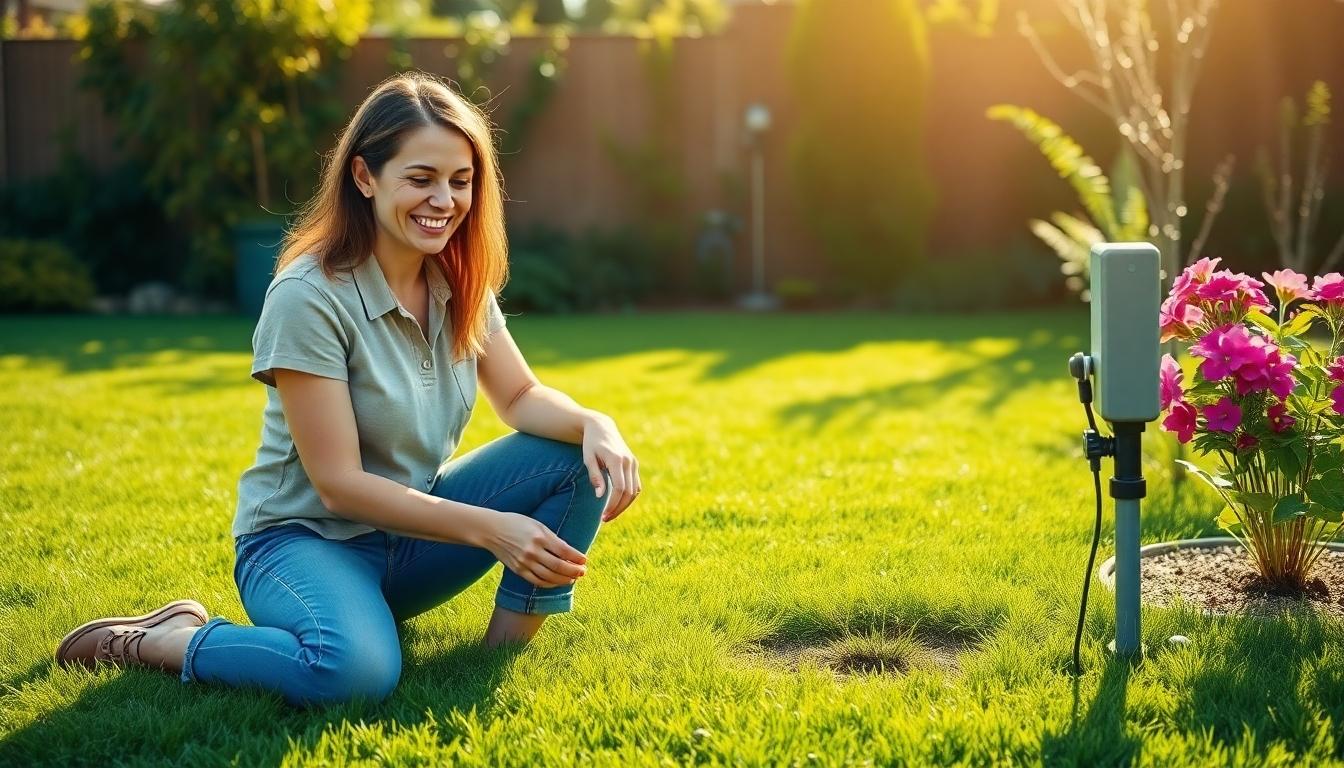
Modern technology has transformed traditional gardening into a more efficient and enjoyable experience. These innovative tools and applications help both novice and experienced gardeners streamline their maintenance routines while achieving professional results.
Smart Phone Apps for Garden Planning
Garden planning apps have become essential tools for organized and successful gardening projects. GrowVeg offers comprehensive planning features specifically designed for vegetable and fruit gardens, allowing users to visualize their space before planting. Planter – Garden Planner provides valuable information about companion and combative plants, plus a customized gardening schedule that keeps you on track throughout the growing season. We’ve found that Seed to Spoon delivers the most comprehensive experience with step-by-step guides, personalized recommendations based on your exact location, and interactive tools that optimize garden layout. The app’s ability to provide customized planting dates based on your geographical location ensures you’re planting at the optimal time for your climate zone. For gardeners focusing on vegetables, Veggie Garden Planner includes detailed plant profiles and companion planting advice that maximizes growth potential.
Automated Watering Systems Anyone Can Install
Watering technology has advanced significantly, making efficient irrigation accessible to everyday gardeners. Smart irrigation controllers connect to weather forecasts and soil moisture sensors, automatically adjusting your watering schedule based on real-time conditions. These systems prevent overwatering during rainy periods and increase irrigation during dry spells without requiring daily adjustments. Drip irrigation systems deliver water directly to plant roots, reducing waste by up to 60% compared to traditional sprinklers while promoting healthier growth patterns. We recommend starting with a simple kit that includes emitters, tubing, and connectors that can be assembled without specialized tools or plumbing knowledge. Smart sensors placed throughout your garden monitor soil moisture, temperature, and light conditions, sending data directly to your smartphone so you can make informed decisions about garden care. For lawn maintenance, robotic mowers operate independently on programmable schedules, maintaining precise cutting heights while you focus on other gardening tasks.
Implement These Expert Garden Hacks Today for a Thriving Landscape
These expert garden hacks prove that you don’t need to be a professional landscaper to create an extraordinary garden. From repurposing household items to harnessing cutting-edge technology, there’s a solution for every garden challenge.
We’ve shared methods that conserve water, deter pests naturally, extend your growing season, and maximize limited space—all while being kind to your wallet and the environment.
The beauty of these techniques lies in their simplicity. Start with just one or two hacks that address your most pressing garden needs, then gradually incorporate others as you gain confidence.
Remember that gardening is a journey of continuous learning. With these expert shortcuts in your toolkit, you’ll create a more productive, beautiful, and sustainable garden that will flourish for years to come.
Frequently Asked Questions
How can I use coffee grounds in my garden?
Coffee grounds are excellent organic fertilizers for acid-loving plants like azaleas, rhododendrons, and blueberries. Simply sprinkle used grounds around the base of these plants to slowly release nitrogen and other nutrients. Coffee grounds also help deter pests like slugs and snails while improving soil structure. For best results, mix the grounds into compost or soil rather than creating a thick layer, which can become water-repellent when dry.
What are the benefits of newspaper weed barriers?
Newspaper weed barriers provide an eco-friendly way to suppress weeds in garden beds. Layer 3-5 sheets of newspaper (avoiding glossy pages) over soil, wet thoroughly, then cover with mulch. The paper blocks sunlight from reaching weed seeds while allowing water and nutrients to reach plant roots. As it decomposes, it adds organic matter to your soil. This method works particularly well when preparing new garden beds or protecting established areas.
How can I create self-watering planters from plastic bottles?
Cut a plastic bottle in half, poke holes in the cap, and invert the top half inside the bottom half with the cap facing down. Fill the top section with soil and plants, and add water to the bottom reservoir. The water slowly releases through the cap holes, providing consistent moisture to plant roots. This technique reduces watering frequency and is ideal for container gardens, especially during hot summer months.
Does vinegar really work as a weed killer?
Yes, household vinegar (5% acetic acid) works as a natural weed killer for young, annual weeds, particularly on sunny days. For tougher weeds, horticultural vinegar (20-30% acetic acid) is more effective but requires careful handling. Apply directly to weed foliage, avoiding desirable plants as vinegar kills indiscriminately. This method works best on weeds growing in cracks or pathways rather than in garden beds with valuable plants.
How do I start seeds in eggshells?
Rinse empty eggshells and poke a small drainage hole in the bottom. Fill with seed-starting mix, plant one seed per shell, and place in an egg carton for stability. Keep moist until germination. When seedlings develop true leaves, plant the entire shell in your garden—it will decompose and provide calcium to the soil. This method eliminates transplant shock and adds nutrients to your growing plants.
What is the benefit of planting perennials in fall?
Fall planting gives perennials time to establish strong root systems before winter dormancy. The soil remains warm while air temperatures cool, creating ideal conditions for root growth without stressing the top growth. Plants require less watering during this season, and many fall-planted perennials perform better the following spring compared to those planted in spring. This timing also allows you to take advantage of end-of-season nursery sales.
How does companion planting work?
Companion planting involves growing mutually beneficial plants together. For example, planting basil near tomatoes improves flavor and repels pests, while marigolds deter nematodes and attract pollinators. Tall plants can provide shade for heat-sensitive crops, and some plants (like beans) fix nitrogen in soil that benefits heavy feeders. This strategy creates biodiversity, reduces pest problems, and maximizes garden space by creating symbiotic plant relationships.
What is compost tea and how do I make it?
Compost tea is a liquid fertilizer made by steeping finished compost in water. Place a cup of compost in a cloth bag, submerge it in a gallon of water, and let it steep for 24-48 hours, stirring occasionally. The resulting liquid contains beneficial microorganisms and nutrients that enhance soil health when applied to plants. Use within a few hours of brewing for maximum effectiveness. It’s an excellent way to stretch your compost supply.
How can I build a simple drip irrigation system?
Create a basic drip system by poking tiny holes in garden hoses or plastic tubing and laying them along plant rows. Connect to a water source with a timer for automation. For an even simpler approach, poke holes in plastic bottles, bury them neck-down near plants, and fill with water. These systems deliver water directly to plant roots, reducing waste and preventing leaf diseases caused by overhead watering.
What are natural alternatives to chemical rooting hormones?
Several kitchen ingredients work effectively as natural rooting stimulants. Cinnamon has antifungal properties that protect cuttings from disease. Aloe vera gel contains hormones that promote root growth—simply dip cutting ends in fresh gel before planting. Banana water (made by soaking banana peels in water for 24 hours) provides potassium that encourages root development. These natural alternatives are cost-effective and environmentally friendly.
How do I create a vertical garden from a pallet?
To create a pallet garden, first line the back and sides with landscape fabric, stapling it in place. Fill with potting soil, then plant through openings between slats. Keep the pallet horizontal for 1-2 weeks to establish roots before standing upright. Choose shallow-rooted plants like lettuces, herbs, strawberries, or succulents. This space-saving solution is perfect for small areas and can be mounted on walls or fences with proper support.
What smartphone apps are helpful for garden planning?
Garden planning apps like GrowVeg and Seed to Spoon help visualize garden layouts, track planting schedules, and provide care instructions specific to your growing zone. These apps offer reminders for watering and fertilizing, identify optimal companion planting combinations, and some even forecast pest problems based on weather data. Many include plant databases with growing requirements and harvest timing, making them valuable tools for both beginners and experienced gardeners.

